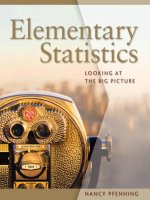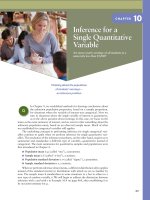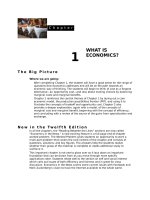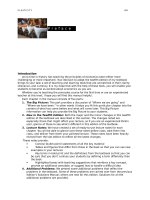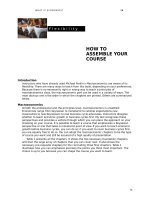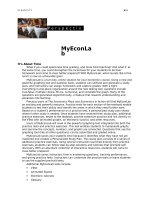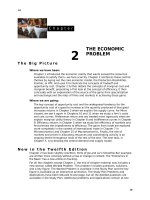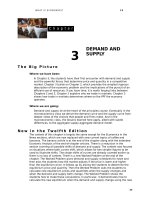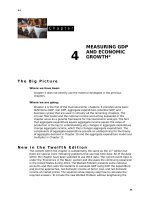The big picture marcoeconomics 12e parkin chapter 15
Bạn đang xem bản rút gọn của tài liệu. Xem và tải ngay bản đầy đủ của tài liệu tại đây (326.81 KB, 10 trang )
W H AT I S E C O N O M I C S ?
137
C h a p t e r
The Big Picture
1
5
INTERNATIONAL
TRADE POLICY
Where we have been:
Chapter 2 introduced the gains from trade in a simple model with a linear
PPF’s. This chapter continues the explanation of the gains from trade by
looking at individual markets using the demand and supply model, first
developed in Chapter 3. The chapter also reviews the effects of, case against,
and reasons for trade restrictions and protection with a focus on the loss
resulting from trade restrictions. You might want to do this chapter after
Chapter 2 and 3 before getting into traditional Macro topics. It could be
especially helpful background information to have prior to discussing
exchange rates in Chapter 9. It can also be helpful to assist the students in
Chapter 4’s discussion of net exports.
N e w i n t h e Tw e l f t h E d i t i o n
This chapter is mostly the same as the 11 th edition with updates to data through
2013. The chapter ends with a new Economics in the News article about the
difficulty of achieving a free trade agreement. A new Worked Problem section has
been introduced. The Worked Problem covers comparative advantage and prices
in the global market. It gives U.S. demand and supply schedules for honey and the
world price of honey. It shows the students how to calculate the no-trade
equilibrium price and quantity and, from these results, how to determine whether
the United States imports or exports honey. Then it demonstrates how the quantity
produced, consumed, and traded internationally changes when honey is opened
to trade. Finally it shows the students how to calculate the U.S. gain from trade
and the distribution of the gains and losses. The study plan problems have been
revised and expanded. To include the new Worked Problem without lengthening
the chapter, some problems have been removed from the Study Plan Problem and
Applications. These problems are in the MyEconLab and are called Extra Problems.
137
Lecture Notes
International Trade Policy
I.
Comparative advantage means that all countries can gain from trade.
Society gains from international trade.
There are many arguments in favor of restricting international trade, but restricting
free trade results in loss to society.
How Global Markets Work
The Big Assumption: Counties cannot be identical! Of all the assumptions economist
make this one is easy to swallow. The basis for international trade is simply recognizing
that countries are different and then exploiting those differences to benefit all countries
involved. Ask your class how countries differ (quality and quantity of resources, climate,
etc.) Now point out to them that one reason to trade is to acquire goods that you cannot
make yourself. A tougher question is why we want to trade for goods that we can make
ourselves.
The goods and services that we buy from people in other countries are called
imports. The goods and services that we sell to people in other countries are called
exports.
International Trade Today
The United States is the world’s largest international trader and accounts for 10 percent of
world exports and 13 percent of world imports.
In 2013, total U.S. exports were $2.3 trillion, which is about 14 percent of the value of
U.S. production.
Total U.S. imports were $2.7 trillion, which is about 17 percent of total expenditure in
the United States.
The value of exports minus the value of imports is called net exports. In 2013, U.S.
net exports were negative $0.4 trillion. (Exports were $2.3 trillion and imports were
$2.7 trillion.)
What Drives International Trade?
The fundamental force that generates international trade is comparative advantage.
A country has a comparative advantage in producing a good if it can produce that
good at a lower opportunity cost than any other country. By specializing in producing
the good for which each country has comparative advantage, both countries gain
from international trade.
For more data on international trade: Data on U.S. international trade can be
accessed at the Bureau of Economic Analysis web site
www.bea.gov/international/index.htm. Key facts worth emphasizing are the enormous
growth in volume of trade over time and huge two-way trade in manufactures. Explain that
the balance of trade results from spending and saving decisions in the United States and
the rest of the world and is independent of the forces that generate the volume of trade,
which this chapter covers.
U.S. Exports
The United States will export goods for
which it has comparative advantage. In
the figure the world price of coal is $60
per ton and the price in the United States
before trade is $40 per ton. The United
States has a comparative advantage in
I N T E R N AT I O N A L T R A D E P O L I C Y
producing coal because the price before trade is lower than the world price. In this
case the United States will export coal.
In the figure, before international trade the price of coal in the United States was $40
per ton and at that price the United States produced 3 million tons of coal per year
and consumed 3 million tons per year. With international trade the price in the
United States rises to the world price, $60 per ton. At that price the United States
produces 5 million tons of coal per year, consumes 1 million tons per year, and
exports the difference, 4 million tons per year.
U.S. Imports
The United States will import goods in
which it does NOT have a comparative
advantage. In the figure, the world price of
automobiles is $20,000 per car and the
price in the United States before trade is
$40,000 per car, so the United States does
not have a comparative advantage in
producing automobiles. In this case the
United States will import cars.
In the figure, before international trade the
price of a car in the United States was
$40,000 per car and at that price the
United States produced 3 million cars per
year and consumed 3 million cars per
year. With international trade the price in
the United States falls to the world price,
$20,000 per car. At that price the United
States produces 1 million cars per year, consumes 5 million cars per year, and
imports the difference, 4 million cars per year.
Winners and Losers From International Trade
When a country starts to export goods, its domestic price rises to the higher world
price. Therefore, exports raise the U.S. price of the good or service domestically. With
the higher price domestic consumers lose and domestic producers gain. On net,
society gains because the winners’ “wins” are larger than the losers’ “losses.”
When a country begins importing, its current domestic price falls to the lower world
price. Therefore, imports lower the U.S. price of the good or service. With the lower
price domestic consumers win and domestic producers lose. On net, society gains
because the winners’ “wins” are larger than the losers’ “losses.”
The Fable of Adam Blackbox: There is an enormously rich heritage of stories, parables,
fables, and satires that you can use to enliven your classes on this topic. The following
fable, inspired by James Ingram (from International Economic Problems, John Wiley, 1970)
is a powerful way to begin. Make up your own version with local flavor and embellishment.
Adam Blackbox announces that he has discovered an amazing way to produce low-price,
high-quality automobiles. He sets up a plant on a large tract of land along the coast of
Massachusetts, hires 10,000 employees, swears them to secrecy, and begins delivering his
low-price, high-quality autos to the nation’s showrooms. Adam Blackbox is hailed as an
American industrial hero. Blackbox Enterprises floats stock and Wall Street booms.
Consumers love him. His automobiles are better and cheaper than those they could buy
before he came along. Automakers hate him, but their attempts to pass laws to restrict his
operations fail. The president and Congressional leaders explain that economic adjustment
is an inevitable consequence of technological advance. And Adam Blackbox’s new
technology for delivering low-price, high-quality automobiles is clearly part of the process
of achieving greater prosperity for all.
.
147
148
CHAPTER 15
The press becomes increasingly curious about what is going on in the giant New England
auto plant. Investigative journalists create endless hours of speculative television
programming on the amazing new technology. Then a tabloid journalist with a big
checkbook finds a worker who is willing to talk. Adam Blackbox's secret is revealed.
Nothing is produced at the plant. Adam Blackbox is a trader, not a producer. He buys grain
from American farmers, exports it to Japan, and imports automobiles from Japan. His
secret revealed, Adam Blackbox is hauled before Congressional committees on fair trade
and denounced as an evil destroyer of American jobs. The president makes a special State
of the Union speech in which he denounces Adam Blackbox, praises a vigilant press for
saving Americans from the threat of cheap foreign labor, and announces a new budget
initiative that will spend $50 billion on research in technologies to produce low cost, highquality automobiles.
Ask your students why the president and Congress accepted Adam Blackbox initially but
then changed their tune. Was Adam Blackbox hurting America or helping America?
II. International Trade Restrictions
Governments restrict international trade to protect domestic industries from foreign
competition using tariffs, import quotas, other import barriers, and subsidies
Tariffs
A tarif is a tax that is imposed by the importing country when an imported good
crosses its international boundary.
A tariff increases the price of the good in
the nation. As a result, the following occur:
Consumers buy less of the good and
producers increase the quantity
supplied;
Government collects tariff revenue
equal to the tariff times the quantity
imported of the good;
Less of the good is imported;
A social loss results.
These results are shown in the figure. The
government imposes a $10,000 per car
tariff on imported automobiles so the U.S.
price rises to $30,000. U.S. consumption of
cars decreases from 5 million per year to 4
million and U.S. production increases from
1 million per year to 2 million so that imports decrease from 4 million per year to 2
million. The government gains tariff revenue.
Import Quotas
An import quota is a restriction that limits
the maximum quantity of a good that may
be imported in a given period.
A quota increases the price of the good in
the nation. As a result, the following occur:
Consumers buy less of the good and
producers increase the quantity
supplied;
The importers collect additional profit;
Less of the good is imported;
A social loss results.
I N T E R N AT I O N A L T R A D E P O L I C Y
These results are shown in the figure. The government imposes a 2 million per year
import quota on automobiles as shown. With this quota the supply curve becomes
the U.S. supply curve below the world price of $20,000 per car and then the U.S.
curve plus the 2 million import quota at prices above the $20,000 world price. The
U.S. price rises to $30,000 per car. As a result U.S. consumption of cars decreases
from 5 million per year to 4 million and U.S. production increases from 1 million per
year to 2 million. Imports decrease from 4 million per year to 2 million.
Other Import Barriers
Although they are not designed to limit international trade, health, safety, and
regulation barriers have that effect.
Voluntary export restraints, while not common, act like a quota and exist if a country
voluntarily limits its exports.
Export Subsidies
An export subsidy is a payment by the government to the producer of an exported
good. Although export subsidies are illegal under many international agreements,
the United States and the European Union pay subsidies to their farmers that result
in increased domestic production, some of which is imported.
III. The Case Against Protection
Arguments for protection include the following:
Helps an infant industry grow: The so-called infant-industry argument for
protection is that it is necessary to protect a new industry to enable it to grow into a
mature industry that can compete in world markets. The idea relates to dynamic
comparative advantage in comparative advantages change over time due to
learning-by-doing (from Chapter 2). However, the infant industries argument only
applies if the benefits of learning-by-doing spill over to other industries.
Counteracts dumping: Dumping occurs when a foreign firm sells its exports at
a lower price than its cost of production. Dumping might be used by a firm that
wants to gain a global monopoly. However, it is difficult to measure the cost of
production so whether dumping is taking place is difficult to determine. And
charging a different export price than domestic price is not necessarily evidence of
dumping because firms often sell goods and services for different prices in different
markets.
Saves domestic jobs: The argument that trade protection saves jobs is flawed.
International trade changes the type of jobs in an economy, but it does not decrease
employment in the aggregate because jobs lost in one sector are offset by jobs
created in other sectors.
Allows us to compete with cheap foreign labor: The argument that trade
protection allows us to compete with cheap foreign labor is flawed. Differences in
real wage rates generally reflect differences in productivity, and competitiveness is
determined by both differences in wages and differences in productivity.
Penalizes lax environmental standards: The argument that trade
liberalization leads to a “race-to-the-bottom” in environmental standards is weak.
Many poorer countries have comparable environmental standards and should not be
targeted. And environmental standards are positively related to income (they are a
normal good). The best way to encourage improved environmental standards is to
allow trade and the economic benefits it brings to poorer countries.
Prevents rich countries from exploiting developing countries: The
argument for protection to prevent people of the rich industrial world from exploiting
the poorer people of the developing countries is wrong. While wage rates in many
developing countries are very low, they would be even lower without foreign demand
for the goods that these countries produce.
.
149
150
CHAPTER 15
Reduces offshore outsourcing that sends good U.S. Jobs to other countries
Offshore Outsourcing
When U.S. firms send jobs that could be done in America to another country, they
are offshoring. If U.S. firms buy finished goods from other U.S. or foreign firms, they
are outsourcing.
Offshoring brings gains from specialization, but those who have invested in human
capital to do a specific job that has now gone offshore will be hurt.
Does free trade exploit workers in developing countries? Students might be
somewhat familiar with the terminology of “exploitation.” Have the students think about
what “exploitation” means in the context of voluntary trade. If I benefit from someone I
trade with, did I exploit them? Did they exploit me? If trade is voluntary, how did I manage
to exploit the person whom I traded with? Is it because I am smarter than the other
person? This seems to be the condescending assumption of those who talk about
exploitation of workers in developing countries. Indeed, representatives from many
developing countries do not see trade as exploitation, but rather see it as a way to improve
standards of living. When these representatives are upset at WTO meetings, it is usually
about the trade restrictions rich countries place on imports from developing countries
keeping developing countries poor.
Why is International Trade Restricted?
Despite arguments against protection, trade is still restricted because key economic
interests benefit from protection.
Tariff revenues provide a relatively inexpensive way for the government to collect
revenues.
Rent seeking is lobbying and other political activity that seek to capture the gains
from trade. While the benefits from liberalized trade are large in the aggregate, they
are widespread across all consumers. Meanwhile, the costs are concentrated on a
smaller number of producers. It is in the interests of those who pay the costs of
liberalized trade to undertake a large quantity of political lobbying to promote
protection.
If the gains from free trade exceed the losses, it is possible to compensate the losers
so that everyone is in favor of free trade. To some extent, unemployment
compensation and job-retraining programs are designed to serve this purpose.
However, providing compensation is difficult because it is hard to identify exactly
who has lost a job as a result of free international trade and not because of other
reasons.
Another fable: There is also a rich heritage of stories, parables, fables, and satires on
protectionism. But it is hard to beat Bastiat’s. Claude Frederic Bastiat (1801–1850) is a
very interesting French economist. An ardent advocate of free trade, he wrote articles with
Richard Cobden (the famous English free trader and opponent of the Corn Laws). His most
wonderful piece is his satirical “Pétition des marchands de chandelles …” “Petition from the
Manufacturers of Candles, Tapers, Lanterns, Sticks, Street Lamps, Snuffers, and
Extinguishers, and from Producers of Tallow, Oil, Resin, Alcohol, and Generally of
Everything Connected with Lighting,” to give it its full title. The basic idea is that the sun
creates unfair competition for candle merchants and a law must be passed to ban all
windows and other openings that enable it to shine its light inside buildings. You can have
a lot of fun with it not only in the context of trade, but also to talk about opportunity cost
and production possibilities.
For further reading: If you haven’t already done so, read this nice little book and use its
basic ideas to illustrate and illuminate the analysis of the false arguments of protectionists:
I N T E R N AT I O N A L T R A D E P O L I C Y
Russell D. Roberts, The Choice: A Fable of Free Trade and Protectionism, Updated and
Revised Edition, 2000, Prentice Hall (ISBN: 0130870528).
The book tells the story of David Ricardo being granted God’s permission to return to Earth
and meet with Ed Johnson, a 1950s U.S. television manufacturer. Ricardo has some powers
that enable him to create counterfactuals and to travel through time. The dialog between
Ricardo and Johnson provides a powerful commentary on the benefits of free trade and the
costs of protectionism.
Unrestricted international trade benefits all the countries involved with trade. Emphasize
the key benefits from unrestricted international trade:
--The gains from international trade arise from the diversity of opportunity costs of
production across countries. The source of prosperity in free trade arises from each
country generating gains from specialization in their comparative advantage, minimizing
its own opportunity cost of production, and sharing in each of the other country’s gains.
--Both exporting and importing domestic industries benefit from free trade. Free trade
liberates each country’s consumption possibilities from the bonds of their own production
possibilities frontier, enabling the consumers in both the importing and exporting country
to enjoy consumption bundles of goods and services that would be unobtainable without
trade.
--Restrictions on international trade hurt the importing firms, the consumers of imports, the
domestic exporting firms, and even the non-exporting firms. Protecting domestic industry
from international competition backfires: i) it increases the relative price that other
countries pay for domestically produced goods and services that are exported; ii) it raises
the price of the imported goods consumed by domestic consumers; and iii) it lowers the
income of producers of the goods for which the country has a comparative advantage in
production by more than the increase in the incomes of those industries that gain from
trade restrictions. Together, these influences decrease the total demand for domestic goods
and services in the country imposing trade restrictions by more than the increase in
demand for those domestic goods and services in industries for which the country does not
have a comparative advantage.
International trade is a “win-win” situation for all countries involved in trade.
This is the most important message that can be delivered from this chapter. All legitimate
counterpoints are rooted in the concern over unequal distributions of the gains from trade
that are created. Emphasize that economic efficiency and economic prosperity can be
achieved only through free trade among nations, and that the gains generated are more
than sufficient to reimburse those individuals whose lives are made worse off from free
trade. Point out that it is the difficulties of implementing such a reimbursement program
are what prevent such programs from being established on a large scale.
There is no good economic argument in support of trade restrictions. Dispel the
many myths surrounding various justifications for imposing trade restrictions. The section
of the chapter entitled “Cases Against Protection” contains concise and complete counterarguments to the often heard justifications for restraining international trade. Emphasize
that economists are overwhelmingly agreed that there is no good argument against free
trade.
The chapter ends with a new Economics in the News on the problems with reaching an
agreement in the Transpacific Partnership trade negotiations. The talks have focused on
cars and agriculture. Failing to reach agreement between the United States and Japan on
these issues is a setback in terms of achieving broader agreement. The analysis shows the
potential gains from reaching a trade agreement.
.
151
152
CHAPTER 15
Additional Problems
1.
2.
Suppose that the world price of bananas is 18 U.S. cents a pound and that
when Australia does not trade bananas internationally, their equilibrium price
in Australia is 12 U.S. cents a pound. If Australia opens up to international
trade, does it export or import bananas? Explain how the price of bananas in
Australia changes. How does the quantity of bananas consumed in Australia
change? How does the quantity of bananas grown in Australia change?
Suppose that in response to huge job losses in the U.S. textile industry,
Congress imposes a 100 percent tariff on imports of textiles from China.
a. Explain how the tariff on textiles will change the price of textiles, the
quantity of textiles imported, and the quantity of textiles produced in the
United States.
b. Explain how the U.S. and Chinese gains from trade will change. Who in the
United States will lose and who will gain?
3.
In the 1950s, Ford and General Motors established a small car-producing
industry in Australia and argued for a high tariff on car imports. The tariff has
remained through the years. Until 2000, the tariff was 22.5 percent. What
might have been Ford’s and General Motor’s argument for the high tariff? Is
the tariff the best way to achieve the goals of the argument?
4.
Use the information below to answer the following question
U.S. Expands China Paper Anti-Dumping Tarif
Responding to a case brought by the NewPage Corporation of Dayton, Ohio,
the U.S. Commerce Department announced it was imposing a tariff of 99.65
percent on imported glossy paper from China. Glossy paper is the type of
paper used to manufacture art books, high-end magazines, textbooks, and
annual reports. In 2006 imports of glossy paper from China was estimated to
be $224 million.
Reuters, May 30, 2007
a. What is dumping? Who in the United States loses from China’s dumping of
glossy paper?
b. What argument might NewPage Corp. have used to persuade the U.S.
Commerce Department to impose a 99.65 percent tariff?
c. Explain who, in the United States, will gain and who will lose from the tariff
on glossy paper. How do you expect the prices of magazines and textbooks
that you buy to change?
Solutions to Additional Problems
1.
With no international trade, the price in Australia is less than that in the world, so
Australia has a comparative advantage in producing bananas. As a result, if Australia
opens up to international trade, it will export bananas. With international trade, the
price of bananas in Australia rises. The higher price leads to a decrease in the
quantity of bananas consumed in Australia. The higher price also leads to an increase
in the quantity of bananas grown in Australia.
2. a. Higher tariffs increase the price U.S. consumers pay for textiles imported from China.
Because the price of Chinese imported textiles rises, the quantity imported
decreases. The quantity of textiles produced in the United States increases.
I N T E R N AT I O N A L T R A D E P O L I C Y
b. This trade restriction means that the U.S. and Chinese gains from trade definitely
decrease. Textile workers and owners of textile firms will gain from the higher price.
Textile consumers will lose from the higher price.
3.
Most likely the argument in favor of the tariff was the infant-industry argument.
According to proponents of this argument, protection is necessary to a new industry to
enable it to grow into a mature industry that can compete in world markets.
Alternatively, Ford and General Motors might also have argued that a high tariff was
necessary to protect Australian jobs. Protection is not the best way to achieve these
goals. A more efficient way to protect infant industries is to subsidize the firms in the
industry. And the jobs lost in the auto sector will be regained in other sectors devoted
to exporting Australian goods.
4. a. Dumping is when a foreign firm sells its exports at a lower price than the cost of
production. U.S. producers of glossy paper lose from China’s dumping of glossy
paper.
b. Dumping is illegal under the rules of international trade, so dumping is regarded as
a justifiable reason for a temporary tariff. NewPage might have argued that Chinese
exporters of glossy paper were charging a price of (approximately) one half the cost
of production. In this case a tariff of 99.65 percent will (approximately) double the
U.S. price of the imported glossy paper, thereby raising the price to the (alleged)
cost of production.
c. The U.S. producers of glossy paper (such as NewPage!) will gain. The U.S.
government also will gain because it will receive additional tariff revenue. U.S.
consumers of glossy paper will lose. The higher price of glossy paper increases the
costs of magazine and textbook publishers. The supply of magazines and textbooks
decreases so their price rises.
Additional Discussion Questions
1. How can we know that the benefits to the economy from free trade
are greater than the benefits accruing to the domestic industry that
is protected from foreign competition? Stress to the students that if
unrestrained international trade creates the efficient outcome for both
countries involved, it also must mean that prosperity for each country is
maximized.
Emphasize that free trade between nations encourages each country to
pursue specialization in production in those industries for which the
country has a comparative advantage relative to other countries.
If the total quantity of goods and services consumed in each country after
international trade is greater than without international trade, then total
incomes accruing to individuals must be greater, which means the
prosperity of each nation’s economy as a whole is greater under free trade.
2. How will countries know which domestic industries have a
comparative advantage in order to allocate resources towards
specialization in producing those goods and services? Specialization
and gains from international trade will arise naturally through relative price
changes on the world market.
When domestic firms within an industry have a lower opportunity cost of
production than firms in other countries, these firms discover that the price
they can receive from foreign buyers (importers from other countries) is
higher than the price they can receive from domestic consumers. These
.
153
154
CHAPTER 15
domestic firms increase output, demand more labor, capital, and raw
materials, and resources flow toward these industries.
When domestic firms within an industry have a higher opportunity cost of
production than firms in other countries, domestic consumers discover that
the price they must pay to foreign sellers for a good than the price they
must pay domestic producers. Domestic consumers switch their purchases
to foreign imports. The domestic firms producing this good decrease
output, decrease their use of labor, capital, and raw materials, and
resources flow away from these firms.
Each country’s economy naturally becomes specialized in producing output
in those industries for which the country enjoys a comparative advantage.
However, for each country to gain, each country must allow consumers
and producers to have free access to foreign markets.
3. Shouldn’t we protect the workers of those industries that are hurt by
foreign competition? Point out that protecting the workers in industries for
which our country does not have a comparative advantage is akin to making
everyone in the economy suffer a lower level of prosperity than under
unrestricted trade—all to ensure that a small minority of people does not
suffer the economic losses associated with relocating to another community
and finding employment in another industry. Use some specific examples in
recent history:
If Congress imposes import quotas on Japanese vehicles being imported
into the United States, tens of thousands of American autoworkers would
be forced to find employment in another industry. Compare this to the tens
of millions of car buyers each year that must pay hundreds or even
thousands of extra dollars for their cars.
In 2002, President George W. Bush signed into law a tariff on foreign steel
by some 30 percent. He effectively cost the hundreds of millions of
American consumers tens of billions of dollars in higher prices for the
myriad of goods containing steel, as well as those goods and services
requiring transportation in trucks, trains, airplanes, and ships that are
made from steel. He did this seeking political support from those states
with a large presence of steel workers who work for firms that could not
make a profit at the unregulated world market price of steel. The
president’s defense was that other nation’s steel industries were receiving
subsidies and had an “unfair “ advantage in production costs, effectively
“dumping” steel in the U.S. markets at prices below production costs. Ask
the students: What is “unfair” about having foreign governments
effectively subsidizing the purchase of automobiles, trucks, and rail and air
transportation by hundreds of millions of American citizens? Point out it is
only “unfair” to the tens of thousands of steel workers who stand to face
job relocation costs of finding work in another industry.
Emphasize that in each of these cases of trade restrictions, the economy as
a whole would have gained from free international trade, but the
autoworkers and the steel workers are groups of people that are much
more easily organized and stand to benefit much more individually from
trade restrictions than the wide-spread American consumers. The result is
successful lobbying efforts to restrict trade to the detriment to all
consumers in the American economy.
